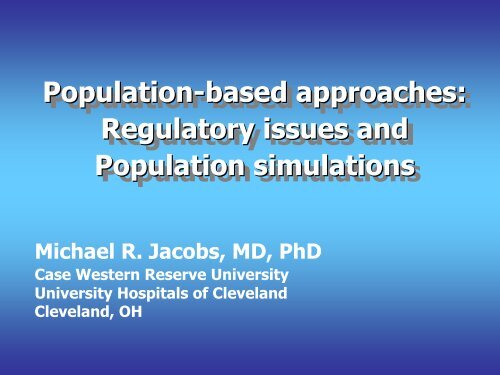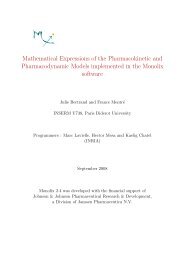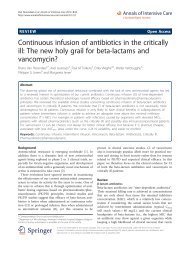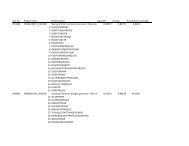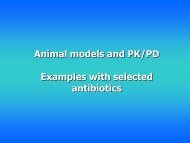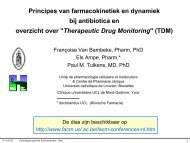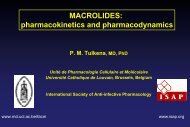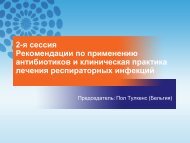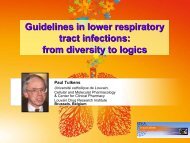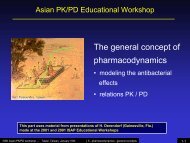Regulatory issues and Population simulations
Regulatory issues and Population simulations
Regulatory issues and Population simulations
Create successful ePaper yourself
Turn your PDF publications into a flip-book with our unique Google optimized e-Paper software.
<strong>Population</strong>-based approaches:<br />
<strong>Regulatory</strong> <strong>issues</strong> <strong>and</strong><br />
<strong>Population</strong> <strong>simulations</strong><br />
Michael R. Jacobs, MD, PhD<br />
Case Western Reserve University<br />
University Hospitals of Clevel<strong>and</strong><br />
Clevel<strong>and</strong>, OH
Topics<br />
<strong>Regulatory</strong> <strong>issues</strong><br />
• <strong>Regulatory</strong> agents require demonstration of<br />
safety <strong>and</strong> therapeutic non-inferiority to<br />
suitable comparator/s for licensing<br />
• “Non-inferiority” in most RTIs is very easy to<br />
demonstrate as most RTIs are self-limiting<br />
<strong>Population</strong>-based <strong>simulations</strong><br />
• In the absence of adequate data, computer<br />
<strong>simulations</strong> of outcome of infection can be<br />
determined using a statistical model that<br />
determined the outcome of infection based on<br />
MIC distributions <strong>and</strong> PK distributions –<br />
referred to as “Monte Carlo <strong>simulations</strong>”<br />
• “Therapeutic outcome model”
“High use”<br />
“Low use”<br />
Lancet 357:1851-1853, 1853, 2001
Outpatient clinical studies in<br />
respiratory tract infections<br />
High-rate spontaneous resolution makes it difficult to<br />
show differences between agents<br />
Bacteriologic outcome studies are not often<br />
performed due to necessity for invasive procedure<br />
(ear, sinus or lung tap) to obtain specimen<br />
Most studies are therefore designed to show<br />
equivalent clinical outcome between established <strong>and</strong><br />
new agents<br />
Inadequacies of agents studied are therefore often<br />
not apparent
<strong>Regulatory</strong> <strong>issues</strong><br />
<strong>Regulatory</strong> agents require demonstration of safety<br />
<strong>and</strong> therapeutic non-inferiority to suitable<br />
comparator/s for licensing<br />
Placebo-controlled studies are almost never<br />
conducted<br />
Formulas used to calculate sample sizes needed in<br />
clinical studies contain assumptions about the<br />
outcome of the disease being studied<br />
Formulas also contain values chosen to represent<br />
the difference between study arms that is<br />
considered “acceptable” <strong>and</strong> is typically set at 10%<br />
to 20%
Assuring Assay Sensitivity<br />
in Non-Inferiority Trials<br />
In a non-inferiority trial, assay sensitivity is not measured<br />
in the trial. That is, the trial itself does not show the<br />
study’s ability to distinguish active from inactive therapy.<br />
Assay sensitivity must, therefore, be deduced or<br />
assumed, based on historical experience showing<br />
sensitivity to drug effects, a close evaluation of study<br />
quality <strong>and</strong>, particularly important, the similarity of the<br />
current trial to trials that were able to distinguish the<br />
active control drug from placebo.<br />
Assay sensitivity can be measured in an active control<br />
trial if there is an “internal st<strong>and</strong>ard,” a control vs placebo<br />
comparison as well as the control vs test drug<br />
comparison (i.e., a three-arm study).<br />
RJ Temple, MD, CDER, FDA, Feb 19, 2002
Historical Evidence of<br />
Sensitivity to Drug Effects<br />
To people's surprise, there are many effective<br />
drugs that cannot be said to have HESDE, i.e.,<br />
that are not regularly superior to placebo in<br />
well-done studies of adequate size<br />
To illustrate, about 46% of well-done trials of<br />
effective antidepressants cannot distinguish<br />
drug from placebo. No one knows how to<br />
choose a population, sample size, or design that<br />
will alter this state<br />
RJ Temple, MD, CDER, FDA, Feb 19, 2002
Clinical Trial Implications:<br />
Sample size per arm to achieve 80% power based<br />
on differences between study arms<br />
Sample Size<br />
1600<br />
1400<br />
1200<br />
1000<br />
800<br />
600<br />
400<br />
200<br />
0<br />
1570<br />
393<br />
175<br />
99<br />
1507<br />
377<br />
168<br />
95<br />
1319<br />
330<br />
147<br />
83<br />
1005<br />
50 60 70 80<br />
Success Rate (%)<br />
252<br />
112<br />
63<br />
<br />
5%<br />
10%<br />
15%<br />
20%<br />
R Albrecht, MD. CDER, FDA, Feb 19, 2002
Consequence to Patients<br />
If accept a delta of 15% instead of delta of<br />
10% as evidence of non-inferiority, the<br />
consequence is that<br />
• the drug is potentially 5% less effective<br />
• an extra 5000 patients may potentially<br />
fail therapy for each 100,000 patients<br />
treated<br />
R Albrecht, MD. CDER, FDA, Feb 19, 2002
Why are conclusions of clinical trials apparently<br />
(sometimes <strong>and</strong> apparently) contradictory ?<br />
insufficient separation of covariables<br />
• only one or a few dosage regimens<br />
not enough true failures<br />
• self-limiting diseases<br />
• study design<br />
intercurrent variables influencing<br />
outcome <strong>and</strong> not recognized as such<br />
insufficient or inappropriate<br />
collection of PK data<br />
• only “peaks” or troughs...<br />
Correct but<br />
incomplete<br />
conclusion<br />
No<br />
conclusions<br />
possible<br />
Conclusions<br />
of poor<br />
value (shed<br />
confusion…)<br />
H. Sun, ISAP-FDA Workshop, 1999
<strong>Regulatory</strong> <strong>issues</strong><br />
“Non-inferiority” in most RTIs is very easy to<br />
demonstrate as most RTIs are self-limiting<br />
Clinical studies of RTIs can be improved if<br />
patients are stratified by disease severity or<br />
other factors that have been shown to be<br />
associated with outcome<br />
• PORT criteria in CAP<br />
• Stratification of AECB patients<br />
• Age in acute otitis media
Patient Stratification in<br />
Community Acquired<br />
Pneumonia (CAP)
Pneumonia Outcomes Research<br />
Team (PORT) Study<br />
Stratified patients into 5 Pneumonia Severity<br />
Index (PSI) risk classes based on risk of<br />
mortality at 30days<br />
PSI can be used to guide decision to<br />
hospitalize patients with CAP<br />
A PREDICTION RULE TO IDENTIFY LOW-RISK PATIENTS WITH<br />
COMMUNITY-ACQUIRED PNEUMONIA<br />
MICHAEL J. FINE, THOMAS E. AUBLE, DONALD M. YEALY, BARBARA H. HANUSA, LISA<br />
A. WEISSFELD, DANIEL E. SINGER, CHRISTOPHER M. COLEY, THOMAS J. MARRIE,<br />
ANDWISHWA N. KAPOOR, N Engl J Med 1997; 336:243-250.
PORT study<br />
The following were independently associated with<br />
mortality:<br />
An age of more than 50 years<br />
Five coexisting illnesses<br />
• neoplastic disease<br />
• congestive heart failure<br />
• cerebrovascular disease<br />
• renal disease<br />
• liver disease<br />
Five physical examination findings<br />
• Altered mental status<br />
• Pulse 125 per minute<br />
• Respiratory rate 30 per minute<br />
• Systolic blood pressure < 90 mm Hg<br />
• Temperature < 35°C or 40°C<br />
Fine MJ, et al. N Engl J Med 1997; 336:243-250.
Fine MJ, et al. N Engl J Med 1997; 336:243-250.
PORT study Pneumonia Severity Index<br />
point allocation<br />
Demographic factor<br />
Points<br />
Age<br />
Men<br />
Age (yr)<br />
Women Age (yr) -10<br />
Nursing home resident +10<br />
Coexisting illnesses†<br />
Neoplastic disease +30<br />
Liver disease +20<br />
Congestive heart failure +10<br />
Cerebrovascular disease +10<br />
Renal disease +10<br />
Physical-examination findings<br />
Altered mental status‡ +20<br />
Respiratory rate30/min +20<br />
Systolic B press
PORT study Pneumonia Severity<br />
Index definitions<br />
†Neoplastic disease is defined as any cancer except basal- or<br />
squamous-cell cancer of the skin that was active at the time of<br />
presentation or diagnosed within one year of presentation.<br />
Liver disease is defined as a clinical or histologic diagnosis of<br />
cirrhosis or another form of chronic liver disease, such as<br />
chronic active hepatitis. Congestive heart failure is defined as<br />
systolic or diastolic ventricular dysfunction documented by<br />
history, physical examination, <strong>and</strong> chest radiograph,<br />
echocardiogram, multiple gated acquisition scan, or left<br />
ventriculogram. Cerebrovascular disease is defined as a<br />
clinical diagnosis of stroke or transient ischemic attack or<br />
stroke documented by magnetic resonance imaging or<br />
computed tomography. Renal disease is defined as a history of<br />
chronic renal disease or abnormal blood urea nitrogen <strong>and</strong><br />
creatinine concentrations documented in the medical record.<br />
‡Altered mental status is defined as disorientation with respect<br />
to person, place, or time that is not known to be chronic,<br />
stupor, or coma.<br />
Fine MJ, et al. N Engl J Med 1997; 336:243-250.
PORT Study Pneumonia Severity<br />
Index classes <strong>and</strong> Mortality<br />
Class Points Mortality(%)<br />
I na 0.1<br />
II =130 29.6<br />
All patients 10.6<br />
Fine MJ, et al. N Engl J Med 1997; 336:243-250.
Patient Stratification in Acute<br />
Otitis Media (AOM)
Correlation of clinical studies with<br />
antimicrobial efficacy in AOM<br />
Bacteriologic outcome during therapy <strong>and</strong> clinical<br />
outcome at end of therapy have been shown to be<br />
the most useful time points to assess therapy<br />
Outcome by 30 days shows no relationship to<br />
treatment due to frequent new viral <strong>and</strong> bacterial<br />
infections<br />
Outcome is worst in patients with risk factors:<br />
Effect of Age on Outcome of AOM<br />
Number of patients<br />
n=293<br />
250<br />
200<br />
150<br />
100<br />
50<br />
0<br />
Bacteriologic success<br />
Bacteriologic failure<br />
183<br />
70<br />
39<br />
Bacteriologic failure rate in<br />
patients treated with<br />
various antibiotic<br />
regimens:<br />
• 18% (39/222) if
Amoxicillin vs Placebo in AOM<br />
Effect of Age on Initial Clinical Failure<br />
Initial Rx Failure<br />
Amox Placebo<br />
Age < 2 yrs 6.5% 9.8%<br />
Age > 2 yrs 0.5% 5.5%<br />
Kaleida et. al. Pediatrics 1991;87:466
Sample sizes required to detect differences between<br />
antibacterial drugs for acute otitis media<br />
Comparison of bacteriologic versus clinical outcomes in trials of two<br />
drugs (half the patients would be in each arm of a study)<br />
Number of patients required<br />
2000<br />
1500<br />
1000<br />
500<br />
0<br />
30 vs<br />
90<br />
40 vs<br />
90<br />
50 vs<br />
90<br />
60 vs<br />
90<br />
70 vs<br />
90<br />
80 vs<br />
90<br />
Bacteriologic efficacy of drug A compared with drug B<br />
Bacteriologic<br />
diagnosis <strong>and</strong><br />
outcome<br />
Bacteriologic<br />
diagnosis/clinical<br />
outcome<br />
Clinical diagnosis<br />
<strong>and</strong> outcome<br />
Marchant et al. J Pediatr 1992; 120:72–77
Azithromycin vs amox-clav<br />
in AOM: clinical<br />
outcome at end of treatment<br />
Amox-clav<br />
Azithro<br />
Percent success<br />
100<br />
80<br />
60<br />
40<br />
20<br />
88 88<br />
100<br />
88<br />
90<br />
92<br />
86<br />
70<br />
0<br />
McLinn Aronovitz Khurana Dagan<br />
Mean age (range) years ? (1-15) 4.0 (2-15) 5.7 (0.5-12) 1.3 (0.5-4)<br />
N evaluable at EOT 553 (82%) 92 (54%) 444 (84%) 143 (60%)<br />
P value for clin. outcome 0.64 0.10 0.42 0.023<br />
No. of patients needed to show:<br />
60% vs 90% bact. efficacy 2000 800 2000 800 clin/100 bact<br />
30% vs 90% bact. efficacy 542 234 542 100 clin/30 bact
Effect of study design on comparative efficacy<br />
of placebo <strong>and</strong> antimicrobials in AOM<br />
Characteristics of patients included in study designs:<br />
* Only patients younger than 2 years old are included, 70% of all cases are<br />
bacterial cases <strong>and</strong> only those with bacterial infections are included in the<br />
bacteriologic efficacy evaluation.<br />
† Clinical failure occurs in only 40% of those with bacteriologic failure after 3<br />
to 5 days of treatment; maximal clinical success occurs in 90% of patients<br />
because even with the best drugs, persistence of symptoms or newly<br />
acquired symptoms (mainly viral infections) will occur in up to 10% of<br />
patients.<br />
‡ The 30% who were initially culture-negative also are included in this group.<br />
On the basis of clinical experience, patients improve quickly, even without<br />
treatment.<br />
§ If some children >2 years of age <strong>and</strong> >3 years of age are included.<br />
In most studies, with clinical diagnosis only, up to 20% do not have acute<br />
otitis media but rather upper respiratory infections only.<br />
Dagan R, McCracken GH. PIDJ 2002: 21:894
Dagan R, McCracken GH. PIDJ 2002: 21:894<br />
Treatment<br />
Effect of study design on comparative efficacy<br />
of placebo <strong>and</strong> antimicrobials in AOM<br />
Bacteriologic<br />
Efficacy (%) in<br />
Culturepositive<br />
Cases (Days 4–<br />
6) – all patients<br />
under 2 years<br />
old*<br />
Clinical<br />
Efficacy<br />
(Days 12–<br />
14) in<br />
culture<br />
positive<br />
patients –<br />
all patients<br />
under 2<br />
years old †<br />
(%)<br />
Clinical<br />
efficacy<br />
including<br />
Patients<br />
with<br />
Negative<br />
Baseline<br />
Culture<br />
(30%)‡<br />
(%)<br />
Cliinical<br />
efficacy<br />
including<br />
30% of<br />
Patients<br />
Older<br />
Than 2 yr<br />
<strong>and</strong><br />
10% Older<br />
Than<br />
3 yr§ (%)<br />
Clinical<br />
efficacy<br />
including 10–<br />
20% of<br />
Patients with<br />
Simple Upper<br />
Respiratory<br />
Tract<br />
Infection (%)<br />
Placebo 30 76 > 80 > 85 90<br />
Agent A 60 84 > 85 90 90<br />
Agent B 90 90 90 90 90
Patient Stratification in Acute<br />
Exacerbations of Chronic<br />
Bronchitis
AECB Stratification Based on<br />
Exacerbation Characteristics<br />
Increase in:<br />
• dyspnea<br />
• sputum volume<br />
• sputum purulence<br />
Type 1<br />
All 3 present<br />
Type 2<br />
2 of 3 present<br />
Type 3<br />
1 of 3 present*<br />
*plus upper respiratory tract infection in the prior 5 days, fever, er, increased<br />
wheezing, cough, <strong>and</strong> respiratory <strong>and</strong>/or heart rates.<br />
Anthonisen et al. Ann Intern Med 1987;106:196.
Antibiotics in AECB<br />
362 exacerbations in 173 patients were<br />
treated with either placebo or antibiotics<br />
(TMP/SMX, doxycycline or amoxicillin)<br />
Cardinal symptoms of exacerbation were<br />
increased dyspnea, sputum volume, sputum<br />
purulence<br />
Anthonisen et al, Ann Intern Med 1987;106:196-204
Antibiotics in AECB<br />
Exacerbations were classified as Type 1, 2 or 3<br />
according to the number of cardinal symptoms<br />
• Type 1: All 3 cardinal symptoms (increased<br />
dyspnea, sputum volume, sputum purulence)<br />
• Type 2: 2 of the 3 present<br />
• Type 3: 1 of the 3 symptoms plus URTI, fever,<br />
cough, wheeze or a 20% increase HR or RR<br />
Anthonisen et al, Ann Intern Med 1987;106:196-204
Antibiotics in AECB<br />
Results<br />
80<br />
p
Antibiotics in AECB<br />
Results<br />
35<br />
% deterioration in<br />
pulmonary function<br />
30<br />
25<br />
20<br />
15<br />
10<br />
5<br />
p
Stratification Based on Patient<br />
Characteristics<br />
Group 1 (acute viral bronchitis)<br />
No previous respiratory problems<br />
Group 2 (simple chronic bronchitis)<br />
Age 65 years; 50%<br />
Group 3 (complicated chronic bronchitis)<br />
Age 65 years; 4 4 exacerbations/year; FEV 1
Antimicrobial Therapy for AECB<br />
Category<br />
Group 1<br />
Probable Pathogen<br />
Viral<br />
Therapy<br />
Symptomatic<br />
Group 2<br />
H. influenzae, S. pneumoniae, Doxycycline,<br />
M. catarrhalis newer macrolide<br />
possibly atypical organisms<br />
newer cephalosporins<br />
Group 3 & 4<br />
As above with the possible<br />
addition of Pseudomonas spp<br />
Enterobacteriaceae, <strong>and</strong> other<br />
Gram-negative pathogens<br />
Amoxicillin/clavulanate,<br />
fluoroquinolones*<br />
*If at risk for infection with Pseudomonas spp, use ciprofloxacin.<br />
Balter et al. Can Med Assoc J 1994;151(suppl 10):5; Adams <strong>and</strong> Anzueto.<br />
Semin Respir Infect 2000;15:234.
Consequences of Inappropriate<br />
Guidelines: A Natural Experiment in<br />
Australia<br />
Australian government directive targeted at reducing<br />
amoxicillin/clavulanate (amox/clav) prescribing<br />
Recommendation that amox/clav should only be used<br />
in infections where resistance to amox was known or<br />
suspected<br />
• Nonsusceptible pneumococci (1997) amox/clav 0.3%,<br />
cefaclor 21.4%, erythromycin 16.3%, tetracycline<br />
15.9%, TMP/SMX 45.8%<br />
No guidance given as to alternative to amox/clav<br />
Data collected on 4 GP practices, 34,242 patients <strong>and</strong><br />
15,303 antibiotic prescriptions for RTIs over 4 years<br />
(1994–1998)<br />
Beilby J, et al. Clin Infect Dis. 2002;34:55–64.
Changes in Prescribing<br />
Shift away from best practice prescribing e.g.,<br />
amoxicillin for otitis media <strong>and</strong> sinusitis<br />
Decrease in prescription share of<br />
amoxacillin/clavulanate: 13.8 8.6%<br />
Increase in prescription share particularly of<br />
macrolides * , tetracyclines, cephalexin <strong>and</strong> cefaclor<br />
*<br />
Roxithromycin <strong>and</strong> erythromycin<br />
Beilby J, et al. Clin Infect Dis. 2002;34:55–64.
Changes in Outcomes<br />
Amoxicillin/clavulanate use shifted to sicker<br />
patients (decreased use for sinusitis)<br />
Increased cost of care<br />
Management became more conservative:<br />
• More radiologic (P=0.00001) investigations<br />
• More pathologic (P=0.005) investigations<br />
More hospitalizations (P=0.005)<br />
? conservatism, ? therapeutic failures<br />
Beilby J, et al. Clin Infect Dis. 2002;34:55–64.
Changes in Outcomes<br />
600<br />
Outcome (rate per month)<br />
500<br />
400<br />
300<br />
200<br />
100<br />
0<br />
Hospitalization Referrals Radiology Pathology Other tests<br />
Before letter<br />
After letter<br />
Beilby J, et al. Clin Infect Dis. 2002;34:55–64.
Summary: A Natural Experiment<br />
in Australia<br />
There was a shift away from best practice<br />
prescribing<br />
There was a significant association between the rate<br />
<strong>and</strong> cost of process-of-care <strong>and</strong> patient outcomes<br />
<strong>and</strong> the decrease in amoxicillin/clavulanate share<br />
This policy created unintended changes in<br />
prescribing behavior, increased cost of care <strong>and</strong><br />
resulted in a trend towards poorer patient outcomes<br />
Beilby J, et al. Clin Infect Dis. 2002;34:55–64.
<strong>Population</strong> based pharmacokinetics<br />
Product labelling gives mean PK values<br />
approved by regulatory agencies<br />
These values are typically obtained in healthy<br />
volunteers<br />
Values in actual patients can vary considerably<br />
from these values, <strong>and</strong> measurement in patients<br />
is desirable<br />
Preston SL, Drusano GL et at. AAC 1998;42:1098-1104<br />
Ambrose PG, Grasela D. ICAAC 1999<br />
Ambrose PG et al Chapter 17 in Antimicrobial Pharmacodynamics in Theory <strong>and</strong> Clinical Prectice, eds<br />
Nightingale CH, Murakawa T, Ambrose PG. 2002. Marcel Decker, NY
<strong>Population</strong> pharmacokinetics:<br />
examples of variations<br />
C max<br />
varies from 5-17 ug/ml<br />
C max<br />
T > MIC<br />
H. Sun, ISAP-FDA Workshop, 1999
Monte Carlo Simulation 1<br />
Monte Carlo simulation is a mathematical technique for<br />
numerically solving differential equations.<br />
The technique tends to be computer intensive, with<br />
many problems taking minutes or hours to solve on a<br />
high speed computer. For this reason, Monte Carlo<br />
simulation is avoided when simple solutions exist for a<br />
problem.<br />
Monte Carlo simulation, however, has the advantage<br />
that it is a "brute force" technique that will solve many<br />
problems for which no other solutions exist. Because<br />
many problems are highly complex, this "method of last<br />
resort" is used frequently.
Monte Carlo Simulation 2<br />
Monte Carlo simulation is typically used to solve<br />
problems which require that one or more statistics of a<br />
probability distribution be calculated by<br />
• “r<strong>and</strong>omly" generating 10,000 scenarios for the data sets<br />
being evaluated<br />
• Determining what the values would be under each of the<br />
10,000 scenarios<br />
• Forming a histogram of those results. This represents a<br />
discrete approximation for the probability distribution of the<br />
data.<br />
• This solution only yields an approximate answer. By using<br />
more scenarios—say 20,000 instead of 10,000—the precision of<br />
the result could be improved. Typically, the precision of a<br />
Monte Carlo simulation is proportional to the square root of the<br />
number of scenarios used.
Monte Carlo Simulation of Distribution of<br />
AUC: MIC Ratios of Gatifloxacin <strong>and</strong><br />
Levofloxacin Against S. pneumoniae<br />
AUC values determined in adult patients<br />
enrolled in clinical studies<br />
MICs of 2000 isolates of S. pneumoniae from<br />
surveillance studies determined<br />
Monte Carlo simulation run on these data using<br />
a 5000 patient simulation r<strong>and</strong>omly pairing AUC<br />
<strong>and</strong> MIC values<br />
A probability distribution is then generated that<br />
reflects the chance that a pharmacodynamic<br />
target will be achieved in a patient<br />
Ambrose PG, Grasela D. ICAAC 1999
AUC values in acutely ill patients<br />
.042<br />
.032<br />
Levofloxacin<br />
500 mg dose<br />
(N=172)<br />
.095<br />
.071<br />
Gatifloxacin<br />
400 mg dose<br />
(N=64)<br />
Probability<br />
.021<br />
Probability<br />
.048<br />
.011<br />
.024<br />
.000<br />
0<br />
100 200 300 400 500<br />
AUC ( g•h/ml)<br />
.000<br />
0 100 200 300 400 500<br />
AUC (g•h/ml)<br />
Preston SL, Drusano GL et at. AAC 1998;42:1098-1104<br />
Ambrose PG, Grasela D. ICAAC 1999<br />
Ambrose PG et al Chapter 17 in Antimicrobial Pharmacodynamics in Theory <strong>and</strong> Clinical Prectice, eds<br />
Nightingale CH, Murakawa T, Ambrose PG. 2002. Marcel Decker, NY
AUC values in acutely ill patients<br />
.042<br />
Levofloxacin 500 mg dose<br />
(N=172)<br />
.032<br />
Probability<br />
.021<br />
.011<br />
.000<br />
0<br />
Labeling: AUC=48 (34 free)<br />
100 200 300 400 500<br />
Preston SL, Drusano GL et at. AAC 1998;42:1098-1104<br />
Ambrose PG, Grasela D. ICAAC 1999<br />
AUC ( g•h/ml)<br />
Ambrose PG et al Chapter 17 in Antimicrobial Pharmacodynamics in Theory <strong>and</strong> Clinical Prectice, eds<br />
Nightingale CH, Murakawa T, Ambrose PG. 2002. Marcel Decker, NY
AUC values in acutely ill patients<br />
.095<br />
Gatifloxacin 400 mg dose (N=64)<br />
.071<br />
Probability<br />
.048<br />
.024<br />
.000<br />
0 100 200 300 400<br />
500<br />
Labeling: AUC=34 (27 free)<br />
Preston SL, Drusano GL et at. AAC 1998;42:1098-1104<br />
Ambrose PG, Grasela D. ICAAC 1999<br />
AUC (g•h/ml)<br />
Ambrose PG et al Chapter 17 in Antimicrobial Pharmacodynamics in Theory <strong>and</strong> Clinical Prectice, eds<br />
Nightingale CH, Murakawa T, Ambrose PG. 2002. Marcel Decker, NY
S. pneumoniae MIC Distribution<br />
Frequency<br />
0.8<br />
0.7<br />
0.6<br />
0.5<br />
0.4<br />
0.3<br />
0.2<br />
0.1<br />
0<br />
Gatifloxacin <strong>and</strong> Levofloxacin<br />
N=2000<br />
0.03 0.06 0.12 0.25 0.5 1 2 4<br />
Ambrose PG, Grasela D. ICAAC 1999<br />
Jones RN. SENTRY Surveillance Program 1997<br />
Gatifloxacin<br />
MIC (ug/ml)<br />
Levofloxacin
Monte Carlo Simulation of Distribution of<br />
AUC: MIC Ratios of Gatifloxacin <strong>and</strong><br />
Levofloxacin Against S. pneumoniae<br />
Probability<br />
0.05<br />
0.045<br />
0.04<br />
0.035<br />
0.03<br />
0.025<br />
0.02<br />
0.015<br />
0.01<br />
0.005<br />
Ambrose PG, Grasela D. ICAAC 1999<br />
0<br />
0 50 100 150 200 250 300 350 400<br />
AUC:MIC ratio<br />
Levofloxacin<br />
Gatifloxacin
Probability of Achieving Target AUC:MIC<br />
Ratio Levofloxacin Vs S. pneumoniae<br />
Probability<br />
0.05<br />
0.045<br />
0.04<br />
0.035<br />
0.03<br />
0.025<br />
0.02<br />
0.015<br />
0.01<br />
0.005<br />
0<br />
0 50 100 150 200 250 300 350 400<br />
AUC:MIC ratio<br />
Levofloxacin<br />
Certainty is 80% from an<br />
AUC:MIC ratio from 30 to<br />
+infinity<br />
Preston SL, Drusano GL et at. AAC 1998;42:1098-1104; Ambrose PG, Grasela D. ICAAC 1999<br />
Ambrose PG et al Chapter 17 in Antimicrobial Pharmacodynamics in Theory <strong>and</strong> Clinical Prectice, eds<br />
Nightingale CH, Murakawa T, Ambrose PG. 2002. Marcel Decker, NY
Probability of Achieving Target AUC:MIC<br />
Ratio Gatifloxacin Vs S. pneumoniae<br />
Probability<br />
0.05<br />
0.045<br />
0.04<br />
0.035<br />
0.03<br />
0.025<br />
0.02<br />
0.015<br />
0.01<br />
0.005<br />
0<br />
94%<br />
0 50 100 150 200 250 300 350 400<br />
AUC:MIC ratio<br />
Gatifloxacin<br />
Certainty is 94% from an<br />
AUC:MIC ratio from 30 to<br />
+infinity<br />
Preston SL, Drusano GL et at. AAC 1998;42:1098-1104; Ambrose PG, Grasela D. ICAAC 1999<br />
Ambrose PG et al Chapter 17 in Antimicrobial Pharmacodynamics in Theory <strong>and</strong> Clinical Prectice, eds<br />
Nightingale CH, Murakawa T, Ambrose PG. 2002. Marcel Decker, NY
Using PK/PD parameters to<br />
develop treatment guidelines
Using PK/PD parameters to develop<br />
sinusitis treatment guidelines<br />
Therapeutic outcome model developed based<br />
on:<br />
Prevalence of pathogens in acute sinusitis<br />
Spontaneous resolution of each pathogen<br />
Bacterial eradication of each pathogen based<br />
on susceptibility at PK/PD breakpoints
Prevalence of pathogens in<br />
acute sinusitis<br />
Figure 3<br />
Microbiology of Acute Bacterial Rhinosinusitis (Adults)<br />
Figure 4<br />
Microbiology of Acute Bacterial Rhinosinusitis (Children)<br />
S. pneum (20-43%)<br />
H. influenzae (22-35%)<br />
Strep spp. (3-9%)<br />
Anaerobes (0-9%)<br />
M. catarrhalis (2-10%)<br />
S. aureus (0-8%)<br />
Other (4%)<br />
S. pneum (25-30%)<br />
H. influenzae (15-20%)<br />
M. catarrhalis (15-20%)<br />
S. pyogenes (2-5%)<br />
Anaerobes (2-5%)<br />
Sterile (20-35%)<br />
Sinus <strong>and</strong> Allergy Health Partnership. Otolaryngol Head Neck Surg 2000;<br />
123(supp 1 part 2):S1–S32
Pharmacodynamic breakpoints for<br />
oral agents used for RTIs<br />
PK/PD breakpoint (µg/ml)<br />
ALL ORGANISMS<br />
Amoxicillin 2<br />
Amox/clav 2<br />
Cefuroxime axetil 1<br />
Cefprozil 1<br />
Cefixime 0.5<br />
Cefaclor 0.5<br />
Loracarbef 0.5<br />
Azithromycin 0.12<br />
Clarithromycin 0.25<br />
Based on M100-S11, National Committee for Clinical Laboratory St<strong>and</strong>ards, 2001; Sinus <strong>and</strong> Allergy Health<br />
Partnership. Otolaryngol Head Neck Surg 2000; 123(supp 1 part 2):S1–S32.
Pharmacodynamic vs. NCCLS<br />
breakpoints (µg/ml)(<br />
NCCLS<br />
PK/PD<br />
S. pneumoniae H. influenzae ALL<br />
ORGANISMS<br />
Amoxicillin 2 4 2<br />
Amox/clav 2 4 2<br />
Cefuroxime axetil 1 4 1<br />
Cefprozil 2 8 1<br />
Cefixime – 1 0.5<br />
Cefaclor 1 8 0.5<br />
Loracarbef 2 8 0.5<br />
Azithromycin 0.5 4 0.12<br />
Clarithromycin 0.25 8 0.25<br />
Based on M100-S11, National Committee for Clinical Laboratory St<strong>and</strong>ards, 2001; Sinus <strong>and</strong> Allergy Health<br />
Partnership. Otolaryngol Head Neck Surg 2000; 123(supp 1 part 2):S1–S32.
Susceptibility of US Isolates at PK/PD breakpoints<br />
Percentage of strains susceptible<br />
Agent S. pneumoniae H. influenzae M. catarrhalis<br />
Amox/clav 90 97 100<br />
Amoxicillin 90 61 14<br />
Cefaclor 27 2 5<br />
Cefixime 57 99 100<br />
Cefpodoxime 63 99 64<br />
Cefprozil 64 18 6<br />
Cefuroxime 64 79 37<br />
Cefdinir ‡ 61 97 100<br />
Azithromycin 67 0 100<br />
Clindamycin* 89 NA NA<br />
Doxycycline 76 20 96<br />
Levofloxacin 99.8 100 99<br />
TMP/SMX* 57 75 9<br />
Based on M100-S11, National Committee for Clinical Laboratory St<strong>and</strong>ards, 2001; Sinus <strong>and</strong> Allergy Health<br />
Partnership. Otolaryngol Head Neck Surg 2000; 123(supp 1 part 2):S1–S32. ‡ Jacobs M. (unpublished)
Sinusitis Therapeutic Outcome Model<br />
100<br />
100<br />
Bacterial efficacy (%)<br />
90<br />
80<br />
70<br />
60<br />
100% efficacy<br />
Fluorquinolones<br />
Amoxicillin-clav.*<br />
Amoxicillin, Cefpodoxime,<br />
Cefuroxime, Cefixime<br />
TMP-SMX,<br />
Doxycycline,<br />
Clindamycin<br />
Cefprozil, Macrolides<br />
Cefaclor, Loracarbef<br />
No treatment<br />
Bacterial efficacy (%)<br />
90<br />
80<br />
70<br />
60<br />
100% efficacy<br />
Amoxicillin-clav.*<br />
Amoxicillin<br />
Cefpodoxime, Cefixime,<br />
Cefuroxime,<br />
Clindamycin, Macrolides,<br />
TMP-SXZ, Cefprozil<br />
Cefaclor, Loracarbef<br />
No treatment<br />
50<br />
Adult<br />
50<br />
Pediatric<br />
40<br />
Bacterial infection<br />
Total patient group<br />
40<br />
Bacterial infection<br />
Total patient group<br />
Sinus <strong>and</strong> Allergy Health Partnership. Antimicrobial Treatment Guidelines for Acute<br />
Bacterial Rhinosinusitis Otolaryngol Head Neck Surg 2000;123(supp 1 part 2):S1–S32<br />
S32
Antimicrobial Recommendations for<br />
Acute Sinusitis<br />
Mild<br />
Moderate<br />
No<br />
Antibiotic Use in Prior<br />
4 to 6 Weeks<br />
Yes<br />
No<br />
Antibiotic Use in Prior<br />
4 to 6 Weeks<br />
Yes<br />
Amox/clav<br />
Amoxicillin<br />
Cefpodoxime<br />
Cefuroxime<br />
Amox/clav<br />
Amoxicillin<br />
Cefpodoxime<br />
Cefuroxime<br />
Amox/clav<br />
Amoxicillin<br />
Cefpodoxime<br />
Cefuroxime<br />
Fluoroquinolone*<br />
Amox/clav<br />
Combination †<br />
*Fluoroquinolone=gatifloxacin/levofloxacin/ moxifloxacin; currently not<br />
approved for use in children. † Amoxicillin or clindamycin plus cefixime.<br />
Sinus <strong>and</strong> Allergy Health Partnership. Otolaryngol Head Neck Surg 2000;123(1<br />
part 2):S1.
Conclusions<br />
Determining the real efficacy of antibiotics is not<br />
easy to obtain as studies are designed to show<br />
“non-inferiority”<br />
Avoiding use of good agents may not be the best<br />
policy<br />
Statistical modeling can provide some additional<br />
information<br />
Therapeutic outcome models are very useful<br />
We need a better way to evaluate antibiotics,<br />
especially in RTIs


